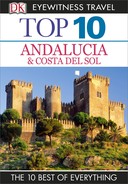Moments in History
1. Bronze Age Developments
The Iberian (Tartessian) civilization got its strongest start around 2500 BC when bronze began to be smelted and worked in Andalucía. Some early tribes built the oldest megalithic tombs (dolmens) in western Europe.
2. Phoenician and Greek Colonies
Attracted by the area’s mineral wealth, the Phoenicians founded a trading post at what is now Cádiz in 1100 BC, while the Greeks established a toehold near Málaga in 636 BC. The two maintained a mercantile rivalry until Carthage, a former Phoenician colony, dominated the region.
3. Roman Spain
The first Roman town in Spain, Itálica, was established in 206 BC; Rome finally wrested the entire region from the Carthaginians in 201 BC. Due to abundant local produce, Andalucía became one of the empire’s wealthiest outposts.
4. Arab Domination
Some 700 years later, when the Roman Empire began to come apart, tribes from northern Europe laid claim to the peninsula. The Vandals and then the Visigoths ruled for some three centuries. Politically unstable, a question of rightful succession in AD 710 led to the enlistment of Muslim armies from North Africa. The Moors saw their chance and within 10 years had taken over.
5. Moorish Sophistication
The Moors were custodians of the best features of Roman civilization: religious tolerance, scientific and philosophical thought, and engineering and cultural refinements. In the 10th century, under the Caliphate of Abd ar-Rahman III, Córdoba became the largest and wealthiest city in Europe.
6. Reconquista
The dissolution of the Caliphate in 1031 marked the beginning of the end for Moorish Spain. Some 30 taifas (principalities), jostling for political hegemony, proved no contest for the Christians. The eight-month siege and reconquista of Granada in 1492 was the most poignant loss.
7. Discovery of America
That same year the New World was discovered for Spain by Christopher Columbus. The result was a wealth of gold and silver from the new empire.
8. Imperial Collapse
Colonial losses that began in 1713 following the War of Spanish Succession reached their dénouement with Spain’s defeat in the Spanish-American War of 1898. In Andalucía this long decline meant grinding poverty and mass emigration.
9. Civil War and Franco
The Spanish Civil War (1936–9) was ignited by a military coup led by General Francisco Franco, who was against Spain’s continuance as a Republic. On 18 July 1936 the war began when they took Cádiz, Seville and Granada. Then followed the grim years (1939–75) of Franco’s repressive dictatorship.
10. Seville Expo ’92
The world fair in 1992 celebrated the quincentenary of Columbus’s discovery of the New World. It brought a sprucing up of Seville and 42.5 million visitors to Andalucía, but it left bankruptcy in its wake. The scale of the economic disaster was political; charges of corruption led to a loosening of the Socialist Party’s hold on power, in favour of a right-wing government.
